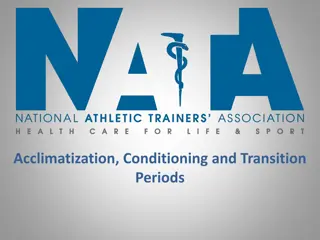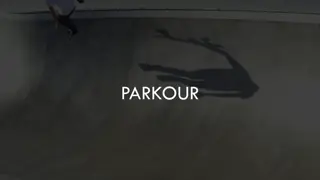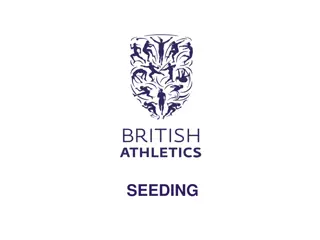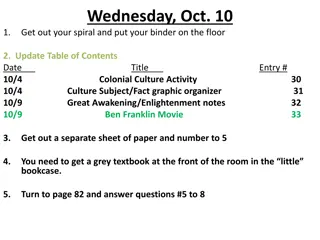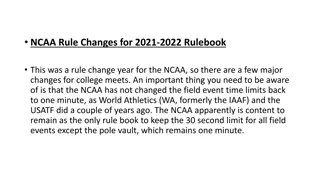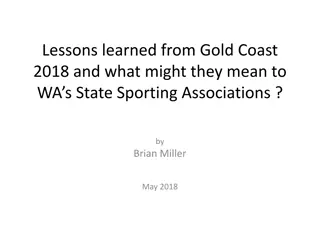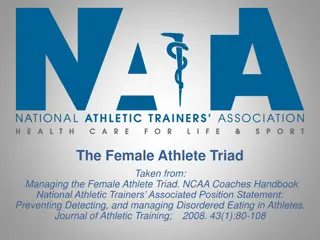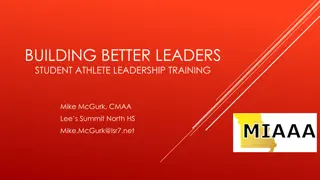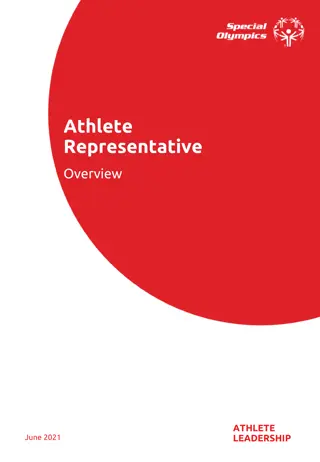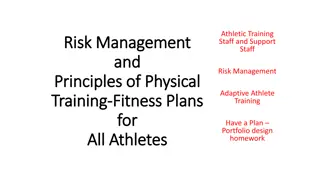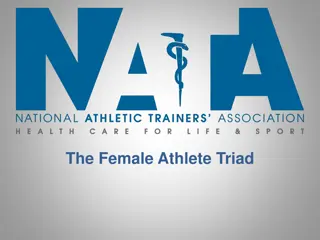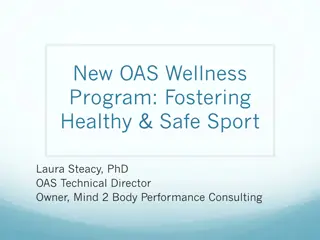Athlete Representative
The essentials of meeting preparation, including setting up meetings, inviting attendees, conducting discussions, and following up post-meeting. Learn how to create agendas, facilitate discussions, and ensure productive outcomes. Enhance your communication skills with practical activities and reflective questions to apply your knowledge in real-world scenarios.
Download Presentation

Please find below an Image/Link to download the presentation.
The content on the website is provided AS IS for your information and personal use only. It may not be sold, licensed, or shared on other websites without obtaining consent from the author.If you encounter any issues during the download, it is possible that the publisher has removed the file from their server.
You are allowed to download the files provided on this website for personal or commercial use, subject to the condition that they are used lawfully. All files are the property of their respective owners.
The content on the website is provided AS IS for your information and personal use only. It may not be sold, licensed, or shared on other websites without obtaining consent from the author.
E N D
Presentation Transcript
Athlete Representative Participant Workbook June 2021
Lesson 1: Preparing for Meetings
Instructions Read the information provided in each lesson Answer the reflective questions at the end For the activities do one of the following: Print out and complete by hand. o Complete on your computer and print. o 3
Lesson 1 Preparing For Meetings What is a meeting? A meeting is when two or more people come together to discuss one or more topics, often in a formal or business setting, but meetings also occur in a variety of other environments. Before a meeting You need to prepare for a meeting to make sure you will have successful participation. ACTIVITY In groups, practice setting up a meeting. Together decide on a topic and review the checklist together: Date: Time: Location: Topic (what you are talking about): How many people are in the meeting? 4
Who is invited to attend? Email Phone Call Announcement How are they invited? please circle one Items from the last meeting New Items The agenda? please circle one Facilitator Checklist Who will take notes? if online or phone, confirm dial-in number, zoom link, etc. Minutes of previous meeting (should be send in advance) do we need a flip chart, markers, projector, presentation or materials? Meeting agenda are any special guests invited? if in person, meeting room reserved and set-up During a meeting? A successful meeting: Starts on time Has enough participants Has an agenda Discussion stays on topic and is productive Has a welcoming environment where people feel safe to share their opinions The group discussions topics and makes a decision Everybody understands the decisions All agree on an action plan or next steps after the meeting 5
ACTIVITY The same groups will meet again and start the meeting they planned before remembering everything they need to do during a meeting. One of the participants should take minutes. When someone is responsible for taking minutes, that means they write down notes or a summary of the meeting: Date: Location: Participants: Facilitator: Special Guests: Notes: Time the meeting started: Time the meeting ended: Read minutes from last meeting. Anyone have any questions or comments? Old business, discuss items pending from last meeting: New business, discuss new items: Next steps: Note taker: 6
After a meeting What to do after ameeting? 1. Passthe meeting notes to all participants(through WhatsApp, email, calls,etc.). 2. Follow up with team members (through WhatsApp, email, calls,etc.). 3. Organize your tasksand complete them. 4. Stayintouch: askquestions, help others. REFLECTIVE QUESTIONS Think about what you have learned and how you can put it into practice: 1 Share something you have learned in this lesson: 2 Thinkabout your role during ameeting. Write anXunder Yesor No: Wouldyouliketo beafacilitator? Yes No Would youlike to write the minutes? Would youlike to follow up with team members and their tasks? Would youlike to havefollow-up discussionswith others? 3 What is something you will do every time you prepare for a meeting? 7
Lesson 2: Meeting Behavior
Lesson 2 Meetings Behavior Meeting Behaviors Abehavior isthe wayinwhichoneacts, especiallytowardothers. Ameeting gathers agroup of people with different personalities,experiences,ideasand expertise. Fora meeting to be successful(seeLesson1) everyoneneeds to contribute. Theirbehaviorsduring the meeting matter. People aredifferent and sothey will act indifferent waysduring a meeting. Here are some examples of common behaviors you will see during ameeting: Listen Remove distractions Respect timing Speak clearly Take turns to speak Make progress 9
ACTIVITY Look through each of the behaviors on the left and the definitions listed on the right. Draw a line to connect each behavior to the correct definition. Combativepersonality. Regularly creates a discussion. Overly talkative Likesto bethe center of attention, may know a lot about the topic and wants to tell everyone, or likesto talksalot. Easily distracted Gets distracted easily, distractsother members and you with side conversations. Uninterested Seemsbored,as if they do not care. Or can comeacrossshy. Argues alot 10
ACTIVITY Here are some tips on how to address the behavior we discussed previously. Divide into groups, each group must have a facilitator that can role play one of the behaviors and ask the other to follow the tips on how to react and improve the situation. After that, ask other members of the group to role play other behaviors Behavior Whatto do? Slowthemdownwithquestions that make themthink. Interruptwith: That saninteresting point... nowlet sseewhatthe group thinksof it. Overly talkative Engage them by asking a question or call on them by name to get their attention. If it persists you can nicely ask them to join the group discussion. Easily distracted Remind everyone this is a safe space and that everyone is free to share their thoughts in a respectful way. Ask their opinion. Learn about their interests. Be sure to compliment them the first time they share and be sincere about it. Uninterested Manage your own emotions. Don t let group get excited either. Review their points to understand their opinion, express your agreement and then move on to something else. As a last resort, talk to them privately during a break. Try to find out what s bothering them. See if you can promote cooperation. Argues alot 11
REFLECTIVE QUESTIONS Think about what youhavelearned andhowyoucanput it into practice: 1Share something you have learned in this lesson: 2 Think about the behavior you show during ameeting. Rememberyour past experiences in meetings and think about what youusually do. Behonest! Inthe activity below, anything that you put anXnext for anegative behavior just meansyouhavesomethingto work on in the future. Mark anXunder Yesor No for eachquestion. Then,reviewthese answerswith a mentor, friend, family member or Special Olympics staff to identify your behaviorsduringmeetings. Yes No Youtendto talkmorethanothers Youarriveontime Youexpressyour ideasbriefly and clearly Youdo not participate during discussions Youtend to feel angryor upset when you do not agree with others Youspeakloudly and overother people in discussions Youstop participating in the meeting when someone interrupts you Youmotivate everyoneto participate Yougetdistracted easily When youdisagree with someone youremaincalm 12
3What is something you will do every time you prepare for a meeting? 4After reviewing your behaviors in meetings, is there something you want to change or improve? Why? 13
Lesson 3: Athlete Leadership Councils
Lesson 3 Athlete Leadership Councils What is an Athlete Leadership Council? Previously known as an Athlete Input Council. The name was changed to better reflect the role this group has in the organization. Providing input is still an important piece but not the only one. The council is a structure created for athletes to: Report to other athletes and Program leaders what is happening in their areas. Voice their peers opinions about important issues related to Special Olympics. Develop, plan, and implement projects. Serves as a liaison in different areas of the organization providing support and expertise. Gain leadership training and experience. This structure exists at a global, regional, national, and local level. Global Athlete Leadership Council Headquarters Regional Athlete Leadership Council Regions National Athlete Leadership Council Programs Local Athlete Leadership Council Sub-Programs 15
ACTIVITY As you learn what an Athlete Leadership Council is, lets reflect on the role. You will be divided into smaller groups so you can discuss the following questions. 1Why is it important for Programs to have an Athlete Leadership Council? 2How can a Special Olympics Program benefit from having an Athlete Leadership Council? 3What are characteristics an athlete needs to be successful in this role? 16
Athlete Leadership Council: Responsibilities Now we will learn about three important responsibilities of Athlete Leadership Council members and the associated actions. Athlete Leadership Council What they do How they do it Know issues related to the Special Olympics Program. Represent other athletes ideas and concerns. Contribute to event planning and implementation. Represent other athletes ideas and concerns. Serve as liaison between athletes and staff in different programmatic areas. LEAD their Special OlympicsProgram Organize Leadership trainings and events in their Special Olympics Program EMPOWER athletes Communicate important issues related to athletes. Model Unified Leadership. Know Special Olympics organization strategic plan and priorities ADVOCATE 17
ACTIVITY After reviewing the ALC member responsibilities let us read the following scenarios and think of which actions can help these athletes be successful in their role. JennaisaSpecialOlympicsbocceathlete and anALCmember. Sheheardtwo athletes expresstheir concerns about not havinga lot of opportunities to compete. Jenna would like to share this with the rest of the Council, but she is not sure if everyone feels this way. WhatwouldyouadviseJennatodo? TheSpecialOlympics Macauteam is planning their National Games. Wang,anALCmember,has participated in some of the planningdiscussion.Shehasmany ideas on how to engage athlete leaders during the Games. Whatwouldyouadvise Wangto do? 18
Athlete Leadership Council: Operations The number of athletes on the council will vary depending on the size and needs of the Special Olympics Program. It is important to have enough athletes to get a variety of input and perspectives. Members Suggested members: Minimum 2-3 athletes. Selection of Members Each Special Olympics Program will ultimately develop the criteria, requirements, and process to select athletes to serve in this role. Suggested criteria: Leadership and Skills Curriculum Core Modules Completed: 1 2 Athlete Representative Module Completed Havea minimumof five yearsof SpecialOlympics experience Introduction to Athlete Leadership UnderstandingLeadership Currently registered athlete Involvedin 1 2 3 Athlete Leadership Participated inasport competition/ program within the last five years Beknowledgeable about SpecialOlympics Haveeffective communications skills (oral, written or listening do not need all three). Able to contribute to meetings. Cancommit to time, requirements, and expectations of the role Suggestedselectionprocess: Open call for athletes interested in participating. Create anevaluation committee composed of SOstaff, coachesand athletes. Length Each Special Olympics Program will determine the term or length of time the members serveon the Council. Suggestedterm: Aterm of three years minimum. 19
Officers All ALCsmusthavea: Chairperson: TheChairperson providesleadership to the ALC; collaborates with SO Program staff; prepares agendas; facilitate calls/ meetings;and attends calls/meetingsregularly. ViceChair: TheViceChaircollaborateswith the Chairperson and performs Chairperson sresponsibilities when Chairperson is unavailable. Secretary: The Secretary takes attendance on calls and at meetings; distributes minutes in a timely manner of all calls/meetings with assistance as needed from facilitator; and distributes agenda for upcoming calls/meetings in a timely manner. Calls/Meetings Each Special Olympics Program and ALC will determine the frequency of their calls/meetings. Suggested term: Monthly or bimonthly calls. Mentors Athletes canchooseto be accompanied byamentor for conferencecallsandin-person meetings. The role of the mentor is to provide the support as needed for the ALC member s preparation to successfully participate in meetings andcalls. 20
ACTIVITY Check your understanding. Read the statement and select the answer you consider to be correct. 1. One of the purposes of the Athlete Leadership Council is: a. For Program staff to delegate responsibilities to. b. Serve as a liaison in different areas of the organization providing support and expertise. c. Lead in all leadership events. 2. Members of the Athlete Leadership Council are expected to: a. Contribute to event planning and execution b. Only provide input on specific topics when asked. c. Voice only their own opinions and experiences. 3. Members of the Athlete Leadership Council serve in their role a. Indefinitely b. For a specific period of time. c. As long as they want to. 4. An important requirement for athletes to be part of an ALC is: a. Be able to read and write. b. Be a medal winning athlete. c. Be knowledgeable about Special Olympics. 5. Mentor that participates in Athlete Leadership Council calls/meetings must: a. Support the athlete so they are prepared for the calls/meetings. b. Voice the athlete s opinion in the calls/meetings. c. Take notes for the members of the ALC. 21
Lesson 4: Committees and Boards of Directors
Lesson 4 Committees and Boards of Directors What is a Special Olympics Committee? The purpose of a committee is to solve problems, plan events, make budgets. Really, they can do just about anything when they work together, and everyone does their share. ACTIVITY Do you know what it takes to be a good committee member? What are responsibilities of all committee members? We need to come up with at least five things, but let us try for seven! Everybody can write their ideas in the chat box. This is an individual activity but you can draft your idea in the box below. 23
Once you have a list compare it with these good behaviors from committee member: Listens to everyone s ideas Research and learn about the issues Make a list of what works and what does not work and why Get input from others outside the committee (i.e. athletes or volunteers) Do not share confidential information with people not on the committee Work together for the best solution Get consensus from the group Act professionally Accept the group decision even if you disagree. What else did you come up with that is missing from the list above? 24
ACTIVITY Divide into smaller groups of 3-5 athletes. Each group will be a Unified Sports committee for a Special Olympics Program, and they need to decide how to spend $5,000 USD in the next 6 months to increase the participation of Unified Partners. We suggest you use break out rooms and when finished let one team leader per group describe their decision-making process. After everyone shares, ask the following questions: How did you feel during the committee meeting? Did you find it easy or challenging? What worked well? What did not work well? Notes: 25
ACTIVITY Special Olympics has different committees for different purposes. Can you think of some? Please write them down here and, when appropriate, share with the group. Herearesomeexamples of SpecialOlympics committees: Athlete Leadership Committee FundraisingCommittee OpeningCeremoniesCommittee Family Committee Volunteer RecruitmentCommittee 26
What is a Special Olympics Boards of Directors? BOARD OF DIRECTORS PRESIDENT&CEO STAFF STAFF STAFF STAFF STAFF TheBoard of Directors sets the policy for the Program and supervises the CEO. Theyalsooverseethe budget for the program. TheBoard of Directors needs to haveenough members sothey cansupervise and makedecisionsin time. Theyshould include members from different locations and different professions who haveexperience in Special Olympics or with intellectual disabilities, or aninterest in developing and expanding SpecialOlympics. Asa requirement all Board of Directors must include at least one: Sport Expert SO Family Member Expert inID SO Athlete 27
ACTIVITY Let us reflect on what we have learned so far. You will be divided into smaller groups so you can answer and discuss the following questions. 1How can a Special Olympics Program benefit from having athletes participating as a board of director and a committee member? 2What are some of the challenges for an athlete serving on a Board of Directors? How would you manage them if you were on a Board? 28
3Think about yourself in these roles. What strengths do you already have that will help you succeed? What would you need to improve? 4What kind of support does an athlete leader need to be successful in these roles? Pleasecomplete the TrainingEvaluationForm: https://bit.ly/3x08Phi (pleasenote:link iscasesensative) 29







